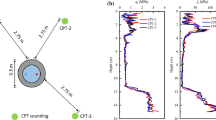Abstract
While sandy silty soils, especially in the river delta area are subjected to liquefaction due to high-intensity earthquakes, the geotechnical profession has gone far and wide in the determination of liquefiable/non-liquefiable zone based on the semi-empirical methodology since the 1970s. Moreover, cyclic triaxial, as well as simple shear tests, on soils have been exploited sequentially to recreate pre- and post-liquefaction situations. There are few laboratory studies to capture the liquefaction effect in soils when subjected to dynamic excitations. In this paper, the effect of manual tapping on the small–medium–large containers filled with soil–water, both visualization of the liquefaction phenomena and measurement of excess PWP has been explained. Simulation of underground utilities and overground buildings in a liquefiable soil has been done with rubber balls affixed with a needle. Capturing the upward movement of the rubber balls and downward movement of the needle fixed rubber balls vis-à-vis instant jumping of water level in the open standpipe piezometer, are some of the unique experimental findings. The results show that out of nine types of soils specimen, the Yamuna River sand in Delhi and the Khowai River sand in Agartala, India, are highly liquefiable, and equivalent PWP variation during dynamic excitation has been measured and simulated during the experiment.
Access this chapter
Tax calculation will be finalised at checkout
Purchases are for personal use only
Similar content being viewed by others
References
Agrawal, S. K., & Chawla. J. (2006). Seismic hazard assessment for Delhi region. Current Science, 91, 1717–1724 (2006).
Boulanger, R. W., & Ziotopoulou, K. (2015). PM4Sand (Version 3): A sand plasticity model for earthquake engineering applications. Report No. UCD/CGM-15/01. Davis (CA): Center for Geotechnical Modeling, University of California; 2015, p. 112.
Chang, W.-J., Rathje, E. M., Stokoe, K. H. II, & Hazirbaba, K. (2007). In Situ pore-pressure generation behavior of liquefiable sand. Journal of Geotechnical and Geoenvironmental Engineering, 133(8), 921–931.
Dobry, R. (1995). Liquefaction and deformation of soils and foundations under seismic conditions, State-of-the-Art Paper. In S. Prakash (ed.), Proceedings, Third Intl. Conf. on Recent Advances in Geotechnical Earthquake Engineering and Soil Dynamics. St. Louis, MO, April 2–7, 3, 1465–1490.
Dobry, R., & Abdown, T. (1988). Post-triggering response of liquefied sand in the free field and near foundations. Proceedings of the Conf. on Geotechnical Earthquake Engineering and Soil Dynamcs III, Seattle, WA, ASCE Geotechnical Special Publication No. 75, Vol. I, pp. 270–300.
Iyengar, R. N. (2000). Seismic status of Delhi megacity. Current Science, 78, 568–574.
Iyengar, R. N., & Ghosh, S. (2004). Microzonation of earthquake hazard in greater Delhi area. Current Science, 87, 1193–1202.
Jiaer, W. U., Kammerer, A. M., Riemer, M. F., Seed, R. B., & Pestana, J. M. (2004). Laboratory study of liquefaction triggering criteria. 13th World Conference on Earthquake Engineering, Vancouver, B.C., Canada, Paper No. 2580.
Kramer, S. L. (1996). Geotechnical Earthquake Engineering, published by Dorling Kindersley [India] Pvt. Ltd. licensees of Pearson Education in South Asia.
Manzari, M. T., El Ghoraiby, M., Kutter, B. L., Zeghal, M., ... & Ziotopoulou, K. (2018). Liquefaction experiment and analysis projects (LEAP): Summary of observations from the planning phase, 113(10), 714–743(2018). https://doi.org/10.1016/j.soildyn.2017.05.015.
O’Rourke, T. D., Gowdy, T. E., Stewart, H. E., & Pease, J. W. (1991). Lifeline performance and ground deformation in the Marina During 1989 Loma Prieta Earthquake. Proceedings of the 3rd Japan-U.S. Workshop on Earthquake Resistant Design of Lifeline Facilities and Countermeasures for Soil Liquefaction, San Francisco, California, NCEER Technical Report NCEER-91–0001, December 17–19.
Oldham, T. A. (1883). Catalogue of Indian earthquakes from the earliest times to the end of AD 1869. Memoirs Geological Society India, 19, 163–215.
Perlea, V. G., & Beaty, M. H. (2010). Corps of Engineers’ practice in the evaluation of seismic deformation of embankment dams. In Proceedings of the Fifth International Conference on Recent Advances in Geotechnical Earthquake Engineering and Soil Dynamics. San Diego: Special Lecture SPL-6; May 24–29, 2010, pp. 1–30.
Prasad, S. K., Towhata, I., Chandradhara, G. P., & Nanjundaswamy, P. (2004). Shaking table tests in earthquake geotechnical engineering. Special Section: Geotechnics and Earthquake Hazards, Current Science, 87(10), 1398–1404.
Rajendran, C. P., & Rajendran, K. (2005). The status of central seismic gap: A perspective based on the spatial and temporal aspects of the large Himalayan earthquakes. Tectonophysics, 395, 19–39.
Rathje, E. M., Chang, W. J., & Stokoe, K. H., II. (2005). Development of an in situ dynamic liquefaction. Geotechnical Testing Journal, 28(1), 65–76.
Seed, H. B., & Idriss, I. M. (1971). Simplified procedure for evaluating soil liquefaction potential. Journal of the Soil Mechanics and Foundations Division, ASCE, 97(SM9), 1249–1273.
Seed, H. B., Idriss, I. M., & Arango, I. (1983). Evaluation of liquefaction potential using field performance data. Journal of the Geotechnical Engineering Division, ASCE, 109(3).
Youd, T. L., & Holzer, T. L. (1994). Piezometer performance at Wild- life liquefaction site, California. Journal Geotechnical Engineering, 120(6), 975–995.
Author information
Authors and Affiliations
Corresponding author
Editor information
Editors and Affiliations
Rights and permissions
Copyright information
© 2023 The Author(s), under exclusive license to Springer Nature Singapore Pte Ltd.
About this chapter
Cite this chapter
Ghosh, C., Bhowmik, S. (2023). Visualization of Liquefaction in Soils with PWP Measurements by Tapping. In: Sitharam, T.G., Jakka, R.S., Kolathayar, S. (eds) Advances in Earthquake Geotechnics. Springer Tracts in Civil Engineering . Springer, Singapore. https://doi.org/10.1007/978-981-19-3330-1_10
Download citation
DOI: https://doi.org/10.1007/978-981-19-3330-1_10
Published:
Publisher Name: Springer, Singapore
Print ISBN: 978-981-19-3329-5
Online ISBN: 978-981-19-3330-1
eBook Packages: EngineeringEngineering (R0)




